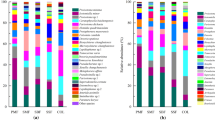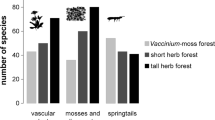Abstract
Opencast mining causes severe environmental impacts by removing the vegetation cover and depleting the fauna. Reforestation methods using native species and diverse pre- and post-disturbance approaches aim to recover the original richness and diversity of species found before the impact. Bioindicators are powerful tools to evaluate the restoration of the original environmental conditions in disturbed areas. We used species richness, endemism and diversity measurements of Collembola to compare successional stages in reforested sites of different ages compared with a control undisturbed area. Richness and abundance of Collembola were subjected to correlation analysis with age of plots and vegetational variables. Areas that were reforested for up to 16 years supported a much lower Collembola species richness than undisturbed areas. Both the age of reforestation plots and vegetation variables (number of trees, diameter of crowns, depth of leaf litter and tree species richness) were positively and significantly correlated to collembolan abundance and richness. The results showed that the diversity of the 16-year-old plot was significantly higher than that of younger areas, but significantly less diverse than that of the control area. Endemic species were more sensitive to disturbance than non-endemics. Thus, species richness and diversity of soil Collembola can be only partially restored with appropriate reforestation methods, and although it takes many years, to some extent even endemic species can be gradually restored. Nevertheless, the maintenance of undisturbed diversity reservoirs linked by ecological corridors to reforested plots is imperative, as only undisturbed areas can support most of the endemic species able to re-colonize reforested sites.




Similar content being viewed by others
References
Addison JA, Trofymow JA, Marshall VG (2003) Abundances, species diversity and community structure of collembola in successional coastal temperate forests on Vancouver island. Can Appl Soil Ecol 24:233–246. doi:10.1016/S0929-1393(03)00090-8
Andrés P, Mateos E (2006) Soil mesofaunal responses to post-mining restoration treatments. Appl Soil Ecol 33:67–78. doi:10.1016/j.apsoil.2005.08.007
Bardgett RD, Keiller S, Cook R, Gilburn AS (1998) Dynamic interpretations between soil animals and microorganisms in upland grassland soils amended with sheep dung: a microcosm experiment. Soil Biol Biochem 30:531–539. doi:10.1016/S0038-0717(97)00146-6
Bellinger PF, Christiansen KA, Janssens F (2007) Checklist of the Collembola of the world. http://www.collembola.org. Accessed Dec 2007
Bellini BC, Zeppelini D (2004) First records of Collembola (Ellipura) from the State of Paraíba, Northeastern Brazil. Rev Bras Entomol 48(4):433–596. doi:10.1590/S0085-56262004000400025
Cassagne N, Gers C, Gauquelin T (2003) Relationships between Collembola, soil chemistry and humus types in forest stands (France). Biol Fertil Soils 37:355–361
Chao A, Shen TJ (2003–2005) Program SPADE (species prediction and diversity estimation). Program and user’s guide published at http://chao.stat.nthu.edu.tw. Accessed Nov 2006
Cole L, Buckland SM, Bardgett RD (2005) Relating microarthropod community structure and diversity to soil fertility manipulations in temperate grassland. Soil Biol Biochem 37:1707–1717. doi:10.1016/j.soilbio.2005.02.005
Colwell RK (2005) EstimateS: statistical estimation of species richness and shared species from samples. Version 7.5 persistent. www.purl.oclc.org/estimates. Accessed Nov 2006
Costa VH, Hernández MIM, Creão-Duarte AJ (2006) Avaliação fitossociológica do reflorestamento de dunas em Mataraca, Paraíba. Encontro Nacional de Gerenciamento Costeiro, Florianópolis, SC. http://www.agenciacosteira.org.br/downloads/resumos/ResumoValderezCostarevisado.doc. Accessed Dec 2007
Culik M, Zeppelini D (2003) Diversity and distribution of Collembola (Arthropoda: Hexapoda) of Brazil. Biol Conserv 12:1119–1143
Deharveng L (1996) Soil Collembola diversity, endemism, and reforestation: a case study in the Pyrenees (France). Conserv Biol 10(1):74–84. doi:10.1046/j.1523-1739.1996.10010074.x
Detsis V, Diamantopoulos J, Kosmas C (2000) Collembolan assemblages in Lesvos, Greece. Effects of differences in vegetation and precipitation. Acta Oecol 21:149–159. doi:10.1016/S1146-609X(00)00110-7
Faber J (1992) Soil fauna stratification and decomposition of the pine litter. Febodruk, Enschede, p 131
Greenslade P, Majer JD (1993) Recolonization by Collembola of rehabilitated bauxite mines in Western Australia. Aust J Ecol 18:385–394. doi:10.1111/j.1442-9993.1993.tb00466.x
Hole FD (1981) Effects of animals on soil. Geoderma 25:75–112. doi:10.1016/0016-7061(81)90008-2
Huhta V, Karppinen E, Nurminen M, Valpas A (1967) Effect of silvicultural practices upon arthropod, annelid and nematode populations in coniferous forest soil. Ann Zool Fenn 4:87–145
Koppen W, Geiger R (1936) Handsbuch der klimatologie. Berlim, Gebruder Borntraeger
Krebs CJ (1999) Ecological methodology, 2nd edn. Addison-Welsey, Menlo Park, p 620
Krebs CJ, Kenney AJ (2000) Programs for ecological methodology, 2nd edn. University of British Columbia, Vancouver
Kumssa DB, van Aarde RJ, Wassenaar TD (2004) The regeneration of soil micro-arthropod assemblages in a rehabilitating coastal dune forest at Richards Bay, South Africa. Afr J Ecol 42:346–354. doi:10.1111/j.1365-2028.2004.00537.x
Neumann FG (1991) Responses of litter arthropods to major natural or artificial ecological disturbances in mountain ash forests. Aust J Ecol 1:19–32
Oliveira EP (1993) Influência de diferentes sistemas de cultivos na densidade populacional de invertebrados terrestres em solo de várzea de Amazônia Central. Amazoniana 12(3/4):495–508
Oliveira-Filho AT, Carvalho DA (1993) Florística e fisionomia da vegetação do extremo norte do litoral da Paraíba. Rev Bras Bot 16(1):115–130
Rosado SCS (2001) Revegetação de dunas degradadas no litoral norte da Paraíba, 28 pp. www.cemac-ufla.com.br/trabalhospdf/palestras/palestra%rosado.pdf. Accessed Jan 2007
Rusek J (1998) Biodiversity of Collembola and their functional role in the ecosystem. Biol Conserv 7:1207–1219. doi:10.1023/A:1008887817883
Salomon JA, Schaefer M, Alphei J, Schmid B, Scheu S (2004) Effects of plant diversity on Collembola in an experimental grassland ecosystem. Oikos 106:51–60. doi:10.1111/j.0030-1299.2004.12905.x
Shear JA (1966) A set-theoretic view of the Koppen dry climates. Ann Assoc Am Geogr 56(3):508–515. doi:10.1111/j.1467-8306.1966.tb00575.x
StatSoft (2001) Statistica (data analysis software system), version 6. www.statsoft.com. Accessed 10 Oct 2001
St. John MG, Bagatto G, Behan-Pelletier V, Lindquist EE, Shorthouse JD, Smith IM (2002) Mite (Acari) colonization of vegetated mine tailings near Sudbury, Ontario, Canada. Plant Soil 245:295–305. doi:10.1023/A:1020453912401
van Bruggen AHC, Semenov AM (2000) In search of biological indicators for soil health and disease suspension. Appl Soil Ecol 15:13–24. doi:10.1016/S0929-1393(00)00068-8
Webb NR (1994) Postfire succession of Cryptostigmatic mites (Acari, Cryptostigmata) in a calluna-heathland soil. Pedobiologia (Jena) 38(2):138–145
Acknowledgments
This research project was funded by CNPq project # 507127/2004-8, with a grant to the senior author under the CNPq/DTI program, M.I.M. Hernández had a CAPES/PRODOC grant. Claudeci S. Silva provided data concerning planting on restored areas, Rodrigo A. Costa, Valderêz H. Costa, Rembrandt R.A.D. Rothéa helped in field work, Helder F. Araújo assisted with statistical analyses, Peter Iverson revised the English and L. Deharveng provided important comments and suggestions. Two anonymous referees greatly improved the manuscript.
Author information
Authors and Affiliations
Corresponding author
Rights and permissions
About this article
Cite this article
Zeppelini, D., Bellini, B.C., Creão-Duarte, A.J. et al. Collembola as bioindicators of restoration in mined sand dunes of Northeastern Brazil. Biodivers Conserv 18, 1161–1170 (2009). https://doi.org/10.1007/s10531-008-9505-2
Received:
Accepted:
Published:
Issue Date:
DOI: https://doi.org/10.1007/s10531-008-9505-2




